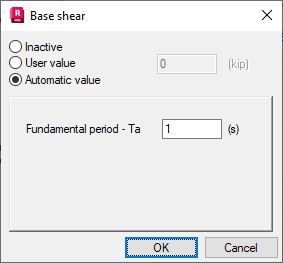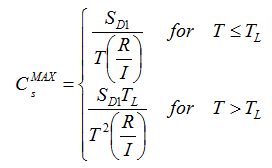- IBC 2009 (IBC 2012), IBC 2000 (IBC 2006).
- UBC 97.
- Canadian NBC 2005, NBC 2010.
- Indian IS: 1893 - 2002.
- Australian AS 1170.4 .
- New Zealand NZS 1170.5:2004.
- US Code ASCE 7-22.
Use this dialog to select how to take account of the base shear force: calculate it according to the provisions of the seismic code (the Automatic value option) or specify it (the User value option).
A seismic load generated in accordance with the Response Spectrum Procedure should not be greater than a load calculated using the simplified method (Equivalent Lateral Force) as a base shear force. Therefore, pseudostatic seismic forces generated in Robot are scaled so that the sum of reactions for the main seismic direction equals the base shear force.
Example: calculation of the seismic base shear according to the US code IBC 2009/IBC 2012

For the seismic analysis according to the US code IBC 2009/IBC 2012, the seismic base shear V is calculated as specified in the code ASCE 7-05 Section 12.8, in two orthogonal horizontal directions using the fundamental period Ta. Internal forces are multiplied by 0.85 V / Vt, when the modal base shear Vt is less than 85 percent of the calculated base shear V using the equivalent lateral force procedure.
Using the equivalent lateral force procedure, the base shear is calculated as:
V = CSW
where:
W - effective seismic weight as in modal analysis
CS - seismic response coefficient calculated as:

The seismic response coefficient must satisfy the following condition:
0.01 ≤ CS ≤ CMAXS
where:

Additionally, for structures located where S1≥ 0.6g:

For further details concerning designations in the formulas above see: Seismic Analysis Parameters (IBC 2009/IBC 2012).
